Hubble Tension, aka the Crisis in Cosmology
Last time we discussed the developments in
physics that led to the birth of an entirely new field within astronomy and
astrophysics—cosmology. It was the combined contributions of giants like
Henrietta Swan Leavitt, Edwin Hubble, Albert Einstein, Georges Lemaitre,
Friedmann et al. through the 20th century that laid the groundwork
for the understanding that the universe is expanding, and that that expansion
recently started accelerating.
While this expansion is not especially noticeable in our immediate galactic neighborhood (for instance, the Andromeda galaxy and other galaxies in the Local group are actually moving towards us since the local influence of gravity dominates over the so-called ‘dark energy’ driving the accelerating expansion of space), over the largest scales of the universe, the universe has been proven to be expanding at an accelerating rate.
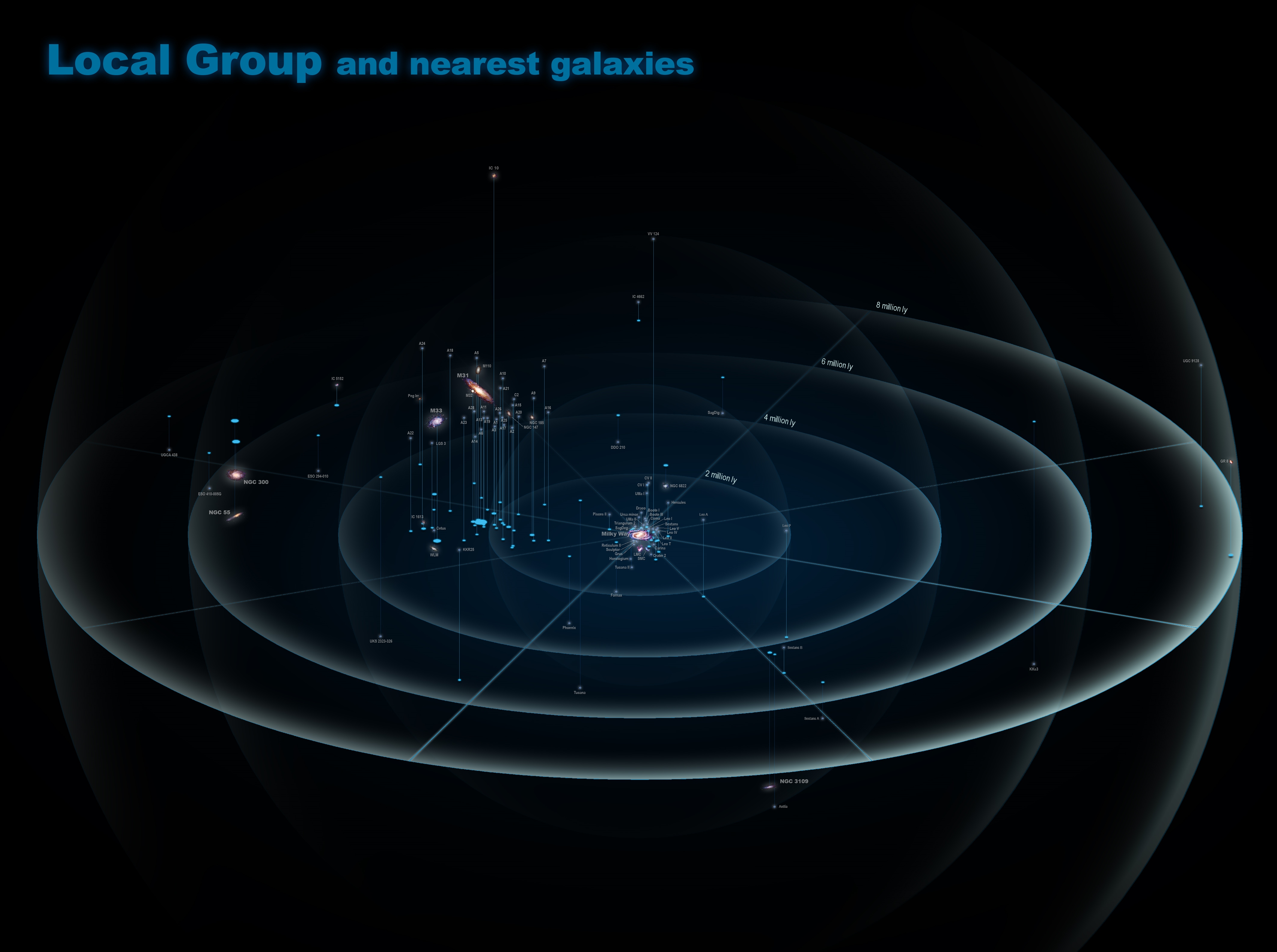 |
| Our galactic neighbourhood, known as the Local Group Credit: Antonio Cicolella's website |
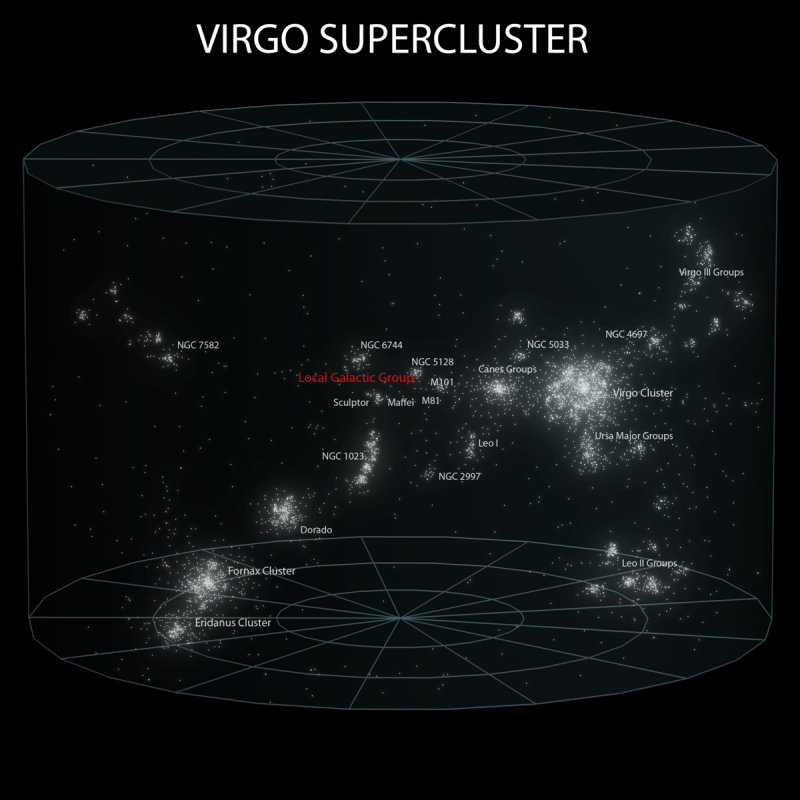 |
| The Local Group within the larger Virgo Supercluster Credit: Wikimedia Commons |
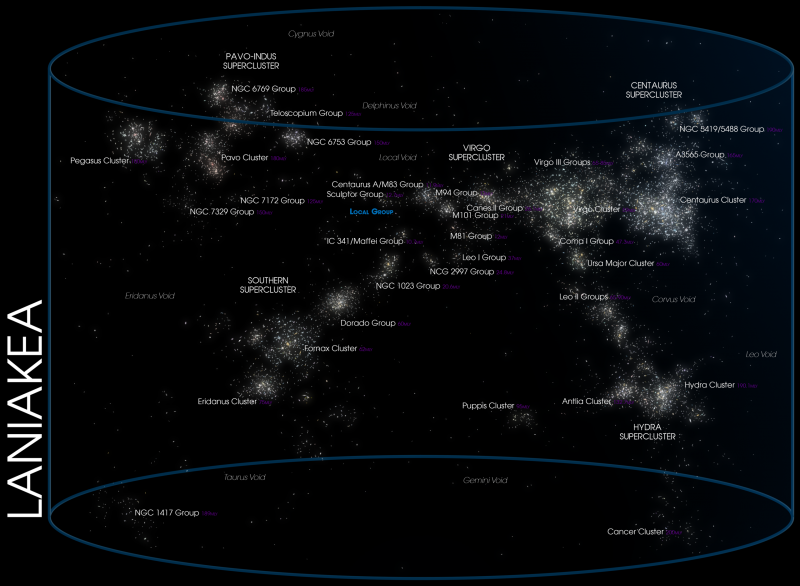 |
| The Local Group within the Virgo Supercluster within the larger Laniakea Supercluster. The universe is big! Credit: Wikimedia Commons |
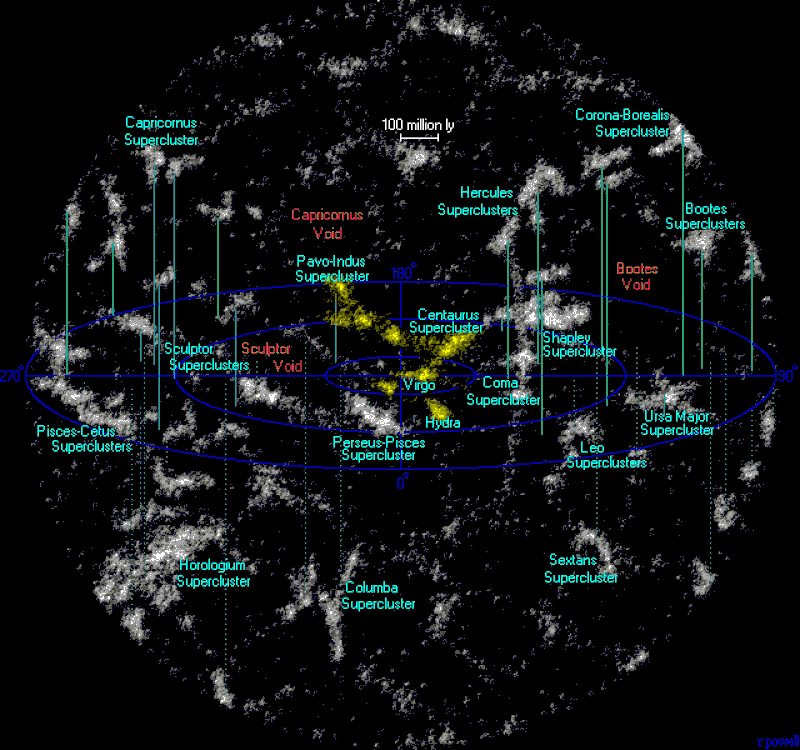 |
| The locations of some superclusters within the observable universe Credit: Wikimedia Commons |
Observations of the redshift of several galaxies throughout the universe and their recessional velocities, as well as distance measurements obtained from “standard candles” like cepheid variables show that the expansion of the universe has been accelerating.
With the knowledge of the expansion of the
universe also came the knowledge that the Milky Way galaxy is not the only galaxy
in the universe—that there are in essence, other “island universes”. The ‘Andromeda
nebula’ became the ‘Andromeda galaxy’, and the entire universe suddenly opened
up.
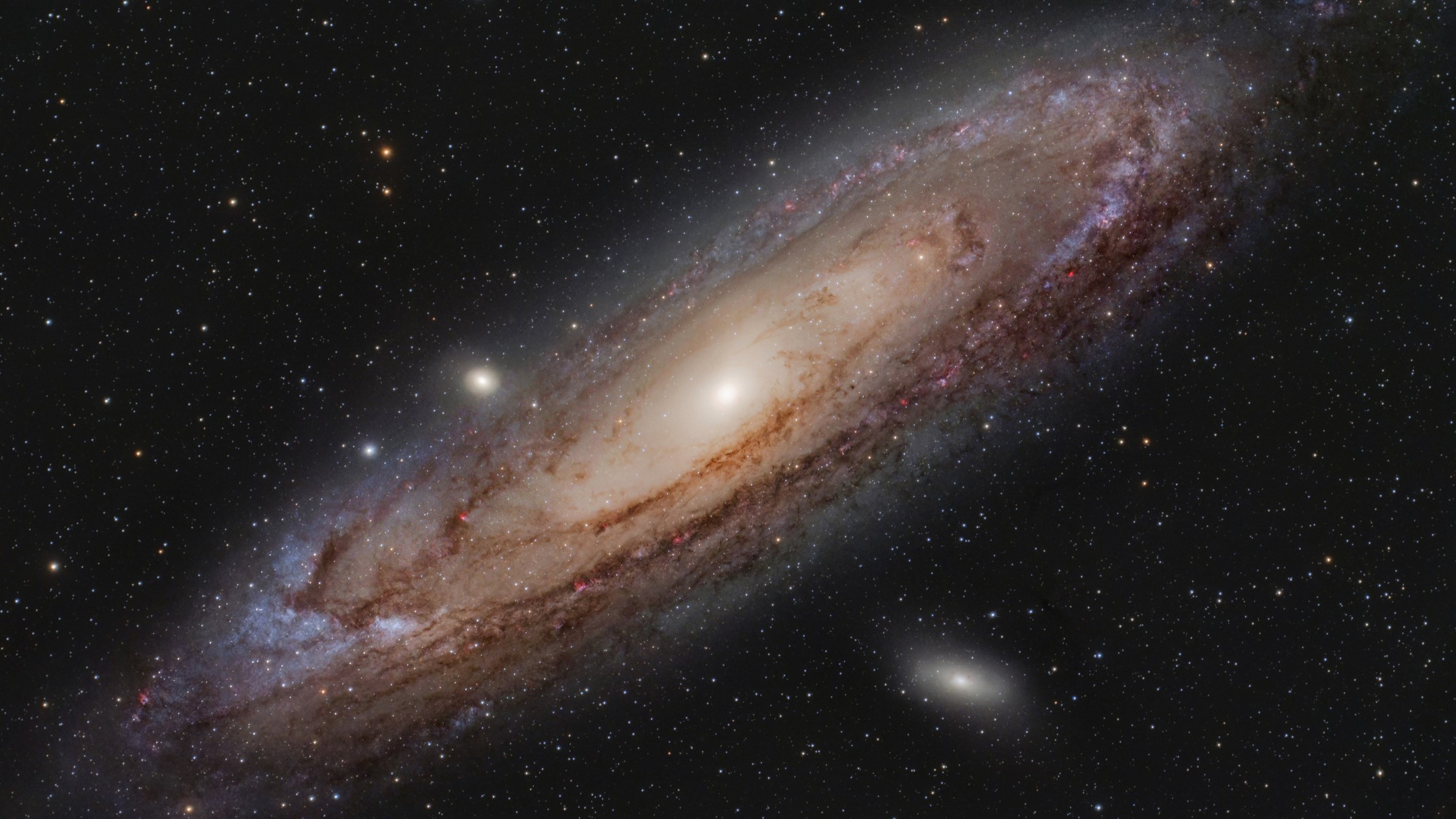 |
| The mighty Andromeda galaxy. Has got quite a ring to it, doesn't it? More so than the 'Andromeda nebula' anyway. Credit: space.com |
The developments in physics and astronomy
over the previous few centuries had been centered on “local” scales. The
earliest astronomical observations of the sky made by the major civilizations (Mesopotamia,
Egypt, India and later Greece and the Islamic world) had all focused on the
Earth, its only natural satellite the Moon (with an uppercase M because it is
our Moon!), the Sun and the solar system. The fairly regular and repetitive
patterns of the planets charting their course through the skies and the
familiar pattern of the Sun and Moon rising and setting everyday formed the basis
of the earliest calendars and “models” of the universe.
The Ptolemaic model, or the Geocentric
model posited that the Earth was the center of the cosmos, with the planets
(and even the Sun!) revolving around it in perfect circular orbits. As absurd as
this model may seem through a modern lens, the model fit most astronomical
observations of the time, discounting a few fringe observations like the
retrograde motion of Mars across the sky. From the point of view of an observer
on Earth, it did seem fairly reasonable that all celestial objects we see in
the night sky revolve around us—even the “fixed” stars leave long streaks
across the dome of the sky as the night progresses.
 |
| An early illustration of one of the oldest models of the universe一 the Ptolemaic model. Illustration by Bartolomeu Velho, 1568. |
Of course, it is not the celestial bodies revolving around the Earth, but the Earth revolving around the Sun and the Earth rotating on its axis that causes this apparent bias. In 1543, Nicolaus Copernicus published De revolutionibus orbium coelestium ("On the Revolutions of the Heavenly Spheres"), which proposed the Heliocentric (or sun-centric) model. While he wasn’t the first to do so, his work greatly influenced Italian astronomer, physicist and polymath Galileo Galilei who would go on to make seminal contributions to mechanics, observational astronomy and the scientific method.
Around the same time, Johannes Kepler (1571-1630)
having identified problems with the perfectly circular orbits of the planets
around the Sun discovered that the only way to make the observations of the
celestial motions (compiled by famed astronomer Tycho Brahe) compatible with
the predictions of the Heliocentric model was to ditch circular orbits in
favour of elliptical ones.
The reasoning for elliptical orbits would
only be provided much later by Sir Isaac Newton’s discovery of the Universal
Law of Gravitation. The mathematical framework he developed in Principia
Mathematica would lay the foundation for the entire field of physics.
Gravitation united seemingly disparate phenomena—it explains why an apple falls to the ground just as satisfactorily as why the Earth follows an elliptical orbit around the Sun. This, in a nutshell, is the triumph of science. Once in a while, an overarching theory develops that encapsulates and explains a wide range of phenomena, and this is the way scientific models are born.
Thus, with every bit of understanding added
to our conception of the universe, a “model” of sorts was created at every step
that compiled the existing knowledge of the behaviour of the universe and tried
making predictions about other aspects of the universe. This illustrates the
“early blueprint” of the scientific method, in which hypotheses based on
observations of nature are rigorously tested by experimentation (or further
observation) and then used to make predictions. The successful hypotheses
develop into overarching models and theories whose predictions are used to
establish their validity. Every prediction that matches the model strengthens
the model, but a single observation against it can topple the entire structure—or
at the very least change it in fundamental ways.
The scope of these models has of course
expanded since the age of Ptolemy, Copernicus, Kepler, Galileo, Newton and even
Einstein—the most significant jump in the scale of the universe all took place in
the past century. With the addition of one final piece to the puzzle, we can
finally discuss the best model of the universe today—ΛCDM—and the “crisis”
cosmology has been undergoing in the past decade or so.
The Cosmic Microwave Background (CMB)
 |
| The Cosmic Microwave Background radiation Credit: ESA/Planck Collaboration |
In a previous post, we touched on how the
developments in the field of cosmology and a close scrutiny of Einstein’s field
equations led Belgian physicist and priest Georges Lemaitre to conclude that
the universe started from an incredibly hot and dense state, and expanded
outwards in a violent birth dubbed the “Big Bang”.
By far the strongest empirical evidence for
“The Big Bang” is the near-perfect blackbody spectrum of the universe—a shell
of uniform radiation that has cooled all the way to microwave end of the spectrum,
and is called the cosmic microwave background, abbreviated as CMB.
The cosmic microwave background is the
oldest light of the universe—it is light that originated when the universe was
only 380,000 years old. It has been traveling for over 13 billion years since,
and could poetically be considered the “birth cry” of the universe.
Why did this light originate after nearly
400,000 years after creation? The answer is that the very young universe was
hot, dense and very opaque. Before 380,000 years, the universe had not had enough
time to cool for atoms to form, and the entire universe was an ultra-hot and
ultra-dense soup of charged particles whizzing about in an extreme state of
matter called plasma. After about 380,000 years the universe cooled enough for
elements to form and it then became transparent to light. This light that
escaped from within this early universe is the cosmic microwave background.
In 1964, Arno Penzias and Robert Woodrow
Wilson had built their most sensitive antenna/receiver system, when the pair
encountered unexpected radio noise that they could not explain. It was far less
energetic than the ambient radiation of the Milky Way, and its isotropic nature
suggested that their instrument was picking up noise and interference from
Earth-based sources itself—an observation that they first attributed to noise
from bustling New York City, and eventually to pigeon droppings. Penzias and
Wilson scrubbed their radio dish clean but to no avail.
 |
| Penzias and Wilson in front of the Holmdell Horn Antenna, 1978 Credit: Linda Hall |
Penzias contacted Robert H. Dicke, explaining the bizarre mystery, who suggested it might be the background radiation predicted by some cosmological theories. The pair agreed with Dicke to publish side-by-side letters in the Astrophysical Journal, with Penzias and Wilson describing their observations and Dicke suggesting the interpretation as the cosmic microwave background (CMB), the radio remnant of the Big Bang.
The cosmic microwave background is the
final piece of the puzzle that was incorporated into an overarching scientific
model describing the evolution and the present conditions of the entire
universe based on Einstein’s General Relativity and the observations of the
accelerating expansion of the universe. This is the current cosmological model,
and is called ΛCDM.
ΛCDM—the Standard Cosmological Model
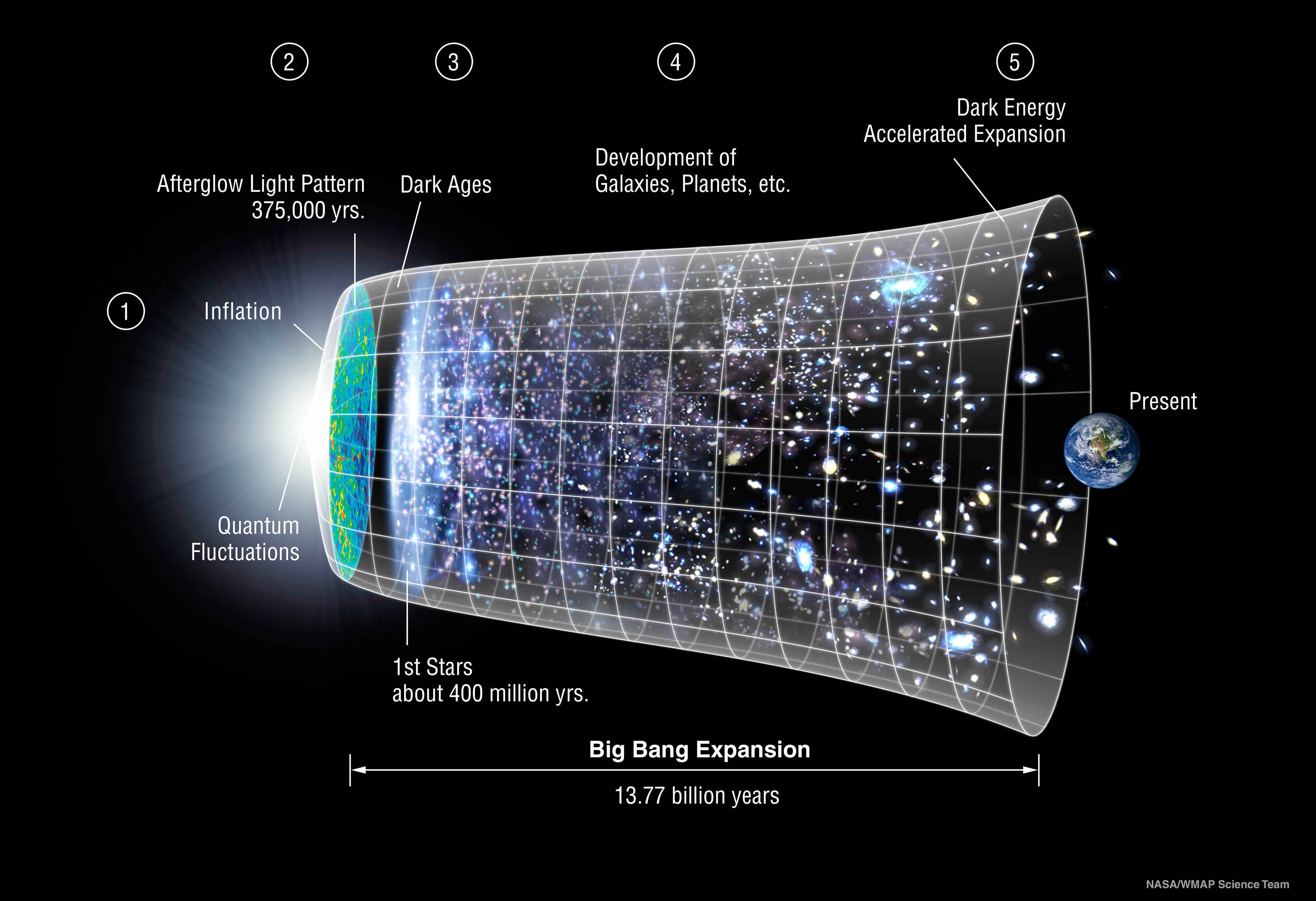 |
| The Standard Cosmological Model一 ΛCDM Credit: NASA/WMAP |
Lambda refers to the Cosmological constant—the term that Einstein added to his equations in order for the field equations to describe a static, unchanging universe. He later chucked it out, calling it one of “his biggest blunders”—only he wasn’t all that wrong after all. After the discovery of the accelerating expansion of the universe, the simplest explanation for what drives this accelerated expansion (famously dubbed Dark Energy) is the Cosmological constant. This is what the Lambda in ΛCDM refers to.
CDM on the other hand is short-hand for
‘Cold Dark Matter’. In order for the universe to evolve into the universe we
currently see today, and explain our observations of both the early and
contemporary universe, the best cosmological model of the universe predicts a very
specific distribution of energy for the universe. 26% of this energy is in the
form of dark matter—an elusive type of matter that is responsible for the fast
rotation rates of galaxies at the edges, and is in no way related to dark
energy.
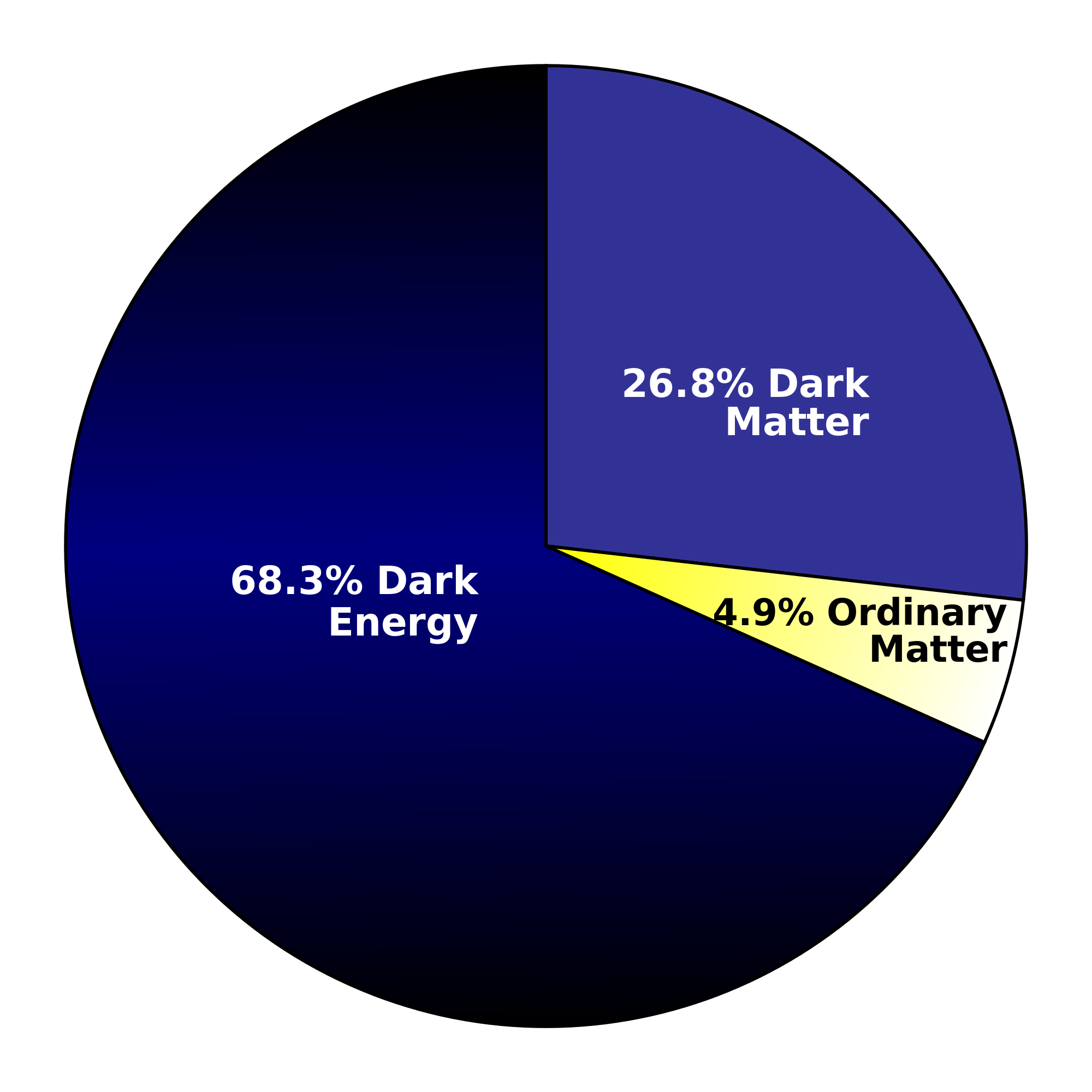 |
| The cosmic energy budget Credit: Dark Energy Survey |
This is the current best model of the entire universe. Where does the “crisis” come in?
Enter, the Hubble tension.
Simply stated, the value of the Hubble
constant (the current expansion rate of the universe) obtained from direct
observations of the universe and from extrapolations of the ΛCDM model do not
agree within observational uncertainty and the inherent uncertainty of the
model.
 |
| The values of the Hubble constant all measured using different observational techniques such as distance ladders, extrapolation from ΛCDM and standard sirens Credit: Jose Maria Ezquiaga et al. |
In fact, each new, more precise observation suggests that the values of the Hubble constant derived from the Lambda-CDM model (the current cosmological model of the universe) fitted to the cosmic microwave background data for the early universe and the value derived from direct observations of the contemporary universe using methods similar to those used by Hubble to calculate the expansion rate, such as distance measurement using standard candles and the redshifts of distant galaxies in the universe, are diverging.
A side note-- the Hubble constant (H0)
is not really a constant—it is just the name given to the value of the Hubble
parameter that denotes the current rate of expansion of the universe. The
subscript '0' indicates the value of the Hubble constant today.
Here are the several methods used to
measure the current expansion rate of the universe (the Hubble constant) and
the values they produce:
Hubble’s original calculations and early
measurements for H0
Hubble’s original estimates of the value of
the expansion rate of the universe that he calculated using observations of
cepheid variable stars as “standard candles” to measure distance back in the
1930s gave a value of H0 of 500 (km/s)/Mpc—a value that is an order
of magnitude too large.
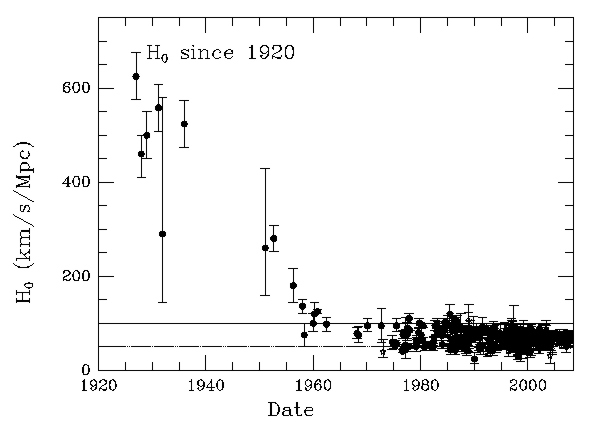 |
| A plot showing the measured values of the Hubble constant as well as the error bars on them, going all the way back to 1920 Credit: J. Huchra, 2008 |
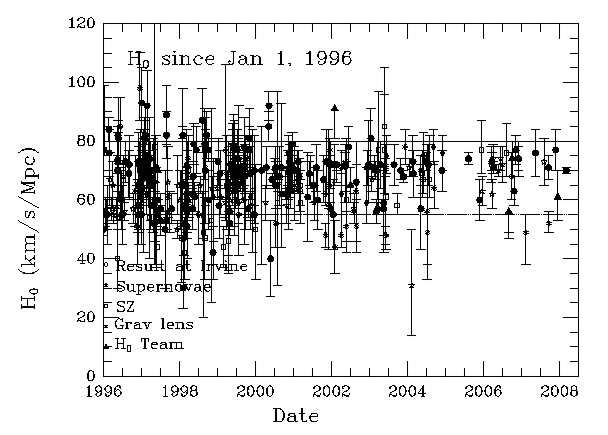 |
| The measured values of the Hubble constant since 1996. Note how all the values cluster between 60 and 80 (km/s)/Mpc. |
In the latter half of the 20th century, the value of the Hubble constant was estimated to lie between 50 and 90 (km/s)/Mpc.
Much more accurate values for H0
were calculated with the introduction of the ΛCDM model, and precision
measurements of the irregularities in the cosmic microwave background. Incorporating
the ΛCDM model, observations of high-redshift clusters at X-ray and microwave
wavelengths all gave a value of around 50–70 km/s/Mpc for the constant.
More precise measurements for H0
The later, more precise measurements for
the Hubble constant, H0 fall into one of two camps: early universe
measurements and contemporary universe measurements.
·
Hubble Space Telescope Key
Project, 2001-05
H0 = 72±8 (km/s)/Mpc
·
Chandra X-ray Observatory,
2006-08
H0 = 76.9+10.7 (km/s)/Mpc
-8.7
| The Hubble Space Telescope Credit: ExtremeTech |
| The Chandra X-ray Observatory Credit: NASA/CXC/NGST |
Early Universe Measurements
‘Early universe’ measurements since the
2000s fit the data obtained from the cosmic microwave background to the
Lambda-CDM model, and give a value of the Hubble constant of round-about 67.7
(km/s)/Mpc.
Some examples of these ‘early universe’
measurement missions include—
·
WMAP (7 years) combined with
other measurements, 2010
H0 = 70.4+1.3 (km/s)/Mpc
−1.4
·
The Planck Mission, 2018
H0 = 67.4±0.5 (km/s)/Mpc
·
SDSS-III Baryon Oscillation
Spectroscopic Survey (BOSS), 2016
H0 = 67.6+0.7 (km/s)/Mpc
−0.6
·
Dark Energy Survey, 2018
H0 = 67.77±1.30 (km/s)/Mpc
Late Universe Measurements
‘Late’ universe measurements refer to
direct measurements of distances and redshift using standard candles like
cepheid variables, Type Ia supernovas, etc. These are the measurements of the
expansion rate of the universe in the contemporary universe, and they give a
value of approximately 73 (km/s)/Mpc.
The "late universe" measurements
are comprised of standard candle measurements like the cepheid variables and
Type Ia supernovae and the red-shift of supernovae.
Some examples of these ‘late universe’
measurements include—
·
Cosmicflows-2, 2013
H0 = 74.4±3.0 (km/s)/Mpc
·
Hubble Space Telescope, 2016
H0 = 73.24±1.74
(km/s)/Mpc
H0 = 71.9+2.4
(km/s)/Mpc
−3.0
·
Cosmicflows-3, 2016
H0 = 76.2+3.4 (km/s)/Mpc
−2.7
As it stands right now, the values for the
Hubble constant have been measured to an ever-increasing amount of precision,
and the more precise the observations get, the more the error bars on the
measurements shrink away from each other.
 |
| A comparison between the values of the Hubble constant measured by both the 'early' and the 'late' measurement camps Credit: Knud Jahnke et al. |
Two sources of measurement, both perfectly valid ways of measuring the expansion rate of the universe lead to a disagreement in values so severe, that the difference in the measured rate of expansion accounts for a difference of a billion years in the age of the universe.
How could the Hubble tension be resolved,
then?
There are a few possible solutions.
Could there be some problem with the
data?
This possibility seems increasingly
unlikely, as measurements get more and more precise with every new paper or
study published on the subject.
The systematic errors on ‘early universe’
measurements are reduced by taking into account the influence of a phenomenon
known as ‘Baryon Acoustic Oscillations’ or BAO, which serve as ‘standard rulers’
in much the same way as cepheid variables serve as ‘standard candles’. Baryon
Acoustic Oscillations occur due to the movement of pressure waves disrupting
surrounding plasma in the early universe. The effects of these pressure waves
can be read off the cosmic microwave background, and can be incorporated to
reduce the error margin.
| An illustration of the clustering of galaxies due to Baryon Acoustic Oscillations in the early universe Credit: NASA Scientific Visualization Studio |
The data has been analyzed and re-analyzed,
and the conclusion is here: the possibility of there being a problem with the
data is increasingly unlikely.
Do we smell new physics?
One possible explanation for this “crisis”
is that we’ve stepped outside the scope of the cosmological model. Often when a
scientific theory or model does not match with experiment or observation, it is
because there is some missing piece or new physics that hasn’t been accounted
for.
It’s also possible that one of the main
assumptions underlying the ΛCDM model is incorrect—there’s the Cosmological
Principle, for example. The Cosmological Principle states that the Universe is
isotropic and homogeneous on the largest scales. This seems like a reasonable
assumption and is supported by some evidence (apart from being backed up by the
mathematics of theory), but it could be incorrect, or incomplete.
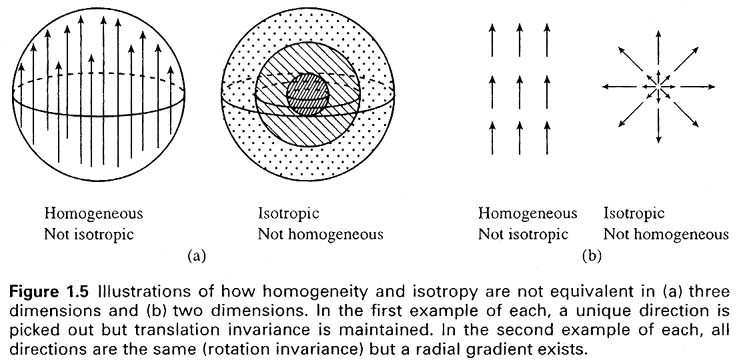 |
| Credit: University of Oregon |
Since dark energy is poorly understood
today, it is possible that we’ll discover new properties that fix this problem.
This is a problem that has captured the
attention of cosmologists around the world. It really is an exciting time for
physics—this rift between observation and model suggests a paradigm shift is on
the horizon. We’ll have to patiently wait to see.
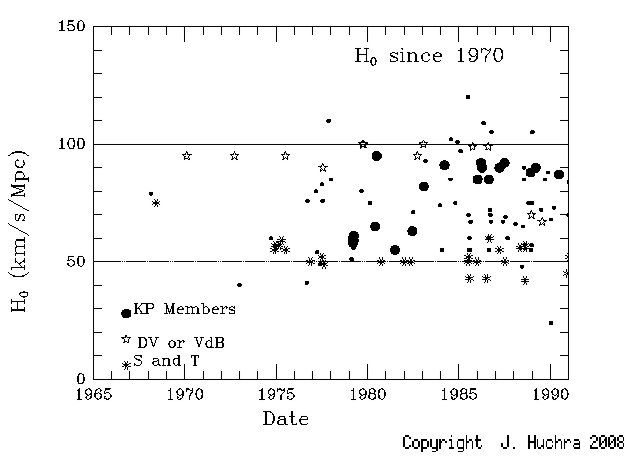
Comments
Post a Comment